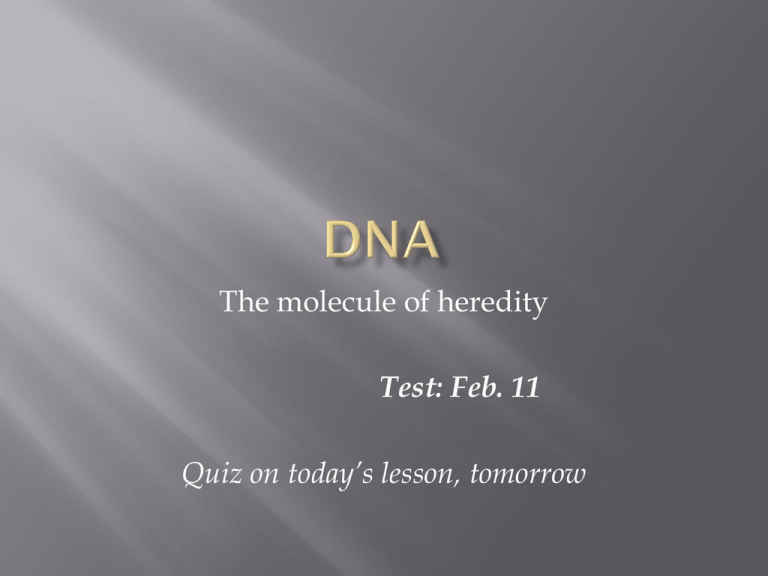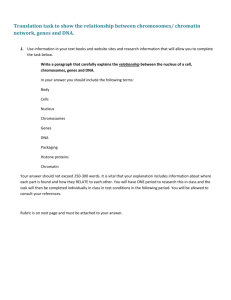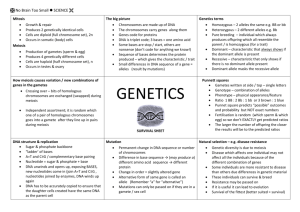DNA
advertisement

The molecule of heredity Test: Feb. 11 Quiz on today’s lesson, tomorrow DNA structure DNA function Inheritance Mitosis/Meiosis Replication Protein synthesis Punnett Squares DNA vs. RNA Organisms have 2 different types of cells Body (somatic) cells: skin, liver, brain Sex cells (gametes): sperm and egg Because sperm and egg need to meet and combine their chromosomes to form a new individual, they have ½ the number of chromosomes as body cells DNA is made up of nucleotides. Each nucleotide of DNA consists of: A sugar “deoxyribose” A phosphate A nitrogenous base: Adenine Cytosine Thymine Guanine PLEASE SKETCH THIS IN YOUR NOTES PLEASE SKETCH THIS IN Double-helix/spiral ladder YOUR NOTES Sugar-phosphate “backbone” Bases are rungs of ladder Long sequences of bases make up genes DNA is located in nucleus of a cell. the ________ While in the nucleus it is in the form of chromosomes . Chromosomes contain the genes Different species have different amounts of chromosomes. Humans = 46 23 46 23 Quiz on yesterday’s lesson (10 min. maximum) When finished, bring to front. “SSR” Silent Sustained Reading (20 minutes) 1. 2. 3. Read pages: 101-103, 110 - 112 Notes on Mitosis and Meiosis (20 min.) Homework (can start at end of class if time): 4. 5. 1. 2. Finish SSR assignment if you didn’t finish in the 20 min. given in class Do text pages: - 103, #1-4 - 112 #1 & 4 - 114 #7 - 9 Turn in HW 2. Genetics Video Clip (10min) www.unitedstreaming.com 1. Meiosis and crossing over 2. Karyotypes HW: Replication and Protein Synthesis Worksheet 1. Mitosis is the division of a cell into body cells. Meiosis is the division of a cell into sex cells. http://www.pbs.org/wgbh/nova/miracle/divi_ flash.html eye color locus eye color locus hair color locus hair color locus From Dad From Mom PLEASE SKETCH THIS IN YOUR NOTES homologous pairs Tetrad, homol. pairs together PLEASE SKETCH THIS IN YOUR NOTES Tetrad This causes genetic variation n=23 human sex cell n=23 sperm n=23 2n=46 haploid (n) diploid (2n) n=23 Crossing-over occurs at this stage PLEASE SKETCH THIS IN YOUR NOTES n=23 n=23 4 genetically different gametes are produced SEX CELLS/HAPLOID (N) 23 12 4 20 10 22 BODY CELLS/DIPLOID (2N) 46 24 8 40 20 44 Review chromosome number Examine karyotypes Discuss chromosomes and genes/inheritance Begin protein synthesis HW: Study for quiz on everything we’ve covered in this unit through today. Closednote quiz. Nondisjunction is when the chromosomes don’t split evenly in meiosis, resulting in too many or too few chromosomes in the sperm or egg. Examples of diseases/conditions caused by non-disjuction: Down’s Syndrome = 47 Turner’s Syndrome = 45 Klinefelter’s Syndrome = 47 http://www.biostudio.com/d_%20Meiotic%20Nondisju nction%20Meiosis%20I.htm Normal Human Karyotype: 46 chromosomes 44 autosomes 23 pairs 22 pairs 2 sex chromosomes 1 pair XX = female XY = male First 30 minutes: Take Quiz and submit to front desk -10 min Protein Synthesis and Genetics – 30 min Homework: Read textbook pages 117-123 and 127-132. Make flashcards of all bold words. Bring to next class Protein Synthesis: How DNA turns the base sequence into proteins DNA RNA Protein It is important for the same DNA to be found in all new daughter cells (created from mitosis). This is done through replication – the copying of DNA DNA holds the instructions for the manufacturing of protein. This is done through protein synthesis – the making of proteins from the instructions coded by the sequence of bases in the DNA http://www.biostudio.com/demo_freeman_protein_synthesis.htm First 35 minutes: Take Quiz and submit to front desk -10 min Read textbook pages 117-123 and 127-132. Make flashcards of all bold words. Bring to next class. Finish for HW if needed Begin Genetics – 25 min Organisms are a product of the genes they receive from their parents. These genes make proteins, such as pigments, that make individuals who they are/what they look like – to an extent….. Genes – segment of DNA that codes for a trait Alleles – different versions of a gene: Allele for brown eyes, allele for blue eyes Both genes code for hair color, but have different versions Letters are used to indicate alleles. Ex. B, b Homozygous – an individual who has the same alleles for a trait. Ex. 2 genes for cystic fibrosis Heterozygous – an individual who has different alleles for a trait. Ex. One gene for cystic fibrosis, one for normal Dominant – The allele that is expressed Recessive – The allele that is not expressed when paired with a dominant. Only expressed when paired with another recessive gene Ex) Heterozygous brown mouse (Bb) 1. how do you know brown is the dominant phenotype? 2. How do you know to use the letter “B” or “b” Parent generation = P Offspring of P generation = F1 Offspring of F1 generation = F2 Cross a homozygous dominant purple flower with a homozygous recessive white flower. Give the F1 genotype and phenotype percents. Purple = PP, white = pp Phenotype: _______ % ___________ _______ % ___________ Genotype: ________% Hom. Dom. ________% Het. ________% Hom. Rec. Cross Bb x Bb 2. Give the F2 of BB x bb 3. Cross a heterozygous black mouse with a white mouse. Give the F1 4. Cross a homozygous dominant black mouse with a white mouse. Give the F2. 5. Cross two carriers (Nn) for cystic fibrosis 6. Cross a normal (NN) with an affected (nn) for cystic fibrosis. 7. Cross a normal with a carrier for tay-sachs *When finished with correct answers checked by a teacher, pair up with someone who needs help. 1.





